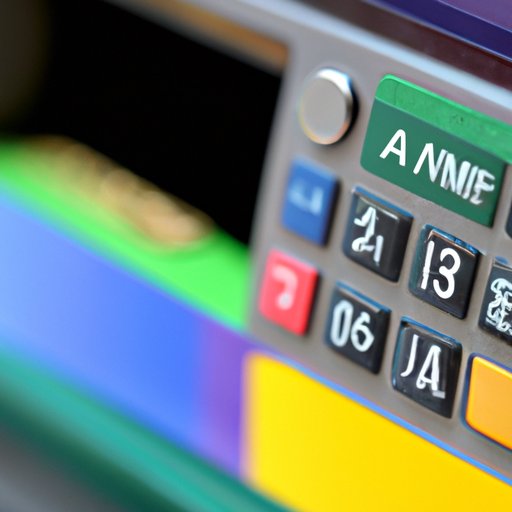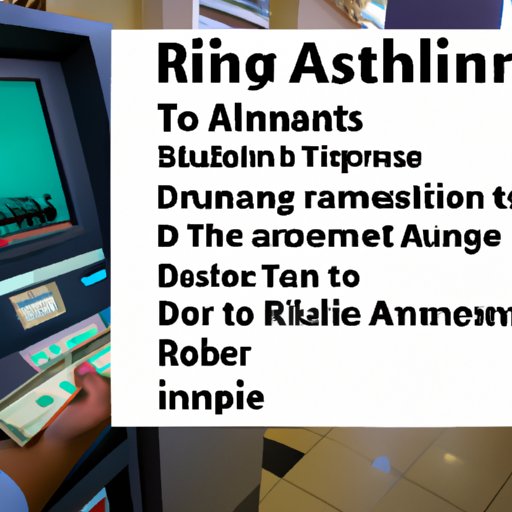
Introduction
Automated Teller Machines (ATMs) are electronic devices that enable customers to carry out banking transactions without the need for a bank teller. ATMs have become commonplace and are now found in most populated areas. As such, it’s essential to understand how to use an ATM. You can easily withdraw money, check your account balance and request a mini-statement with these machines.
Step-by-Step Guide on How to Use an ATM Machine
Here is a step-by-step guide on how to use an ATM machine:
Inserting your card
Insert your ATM or debit card by sliding it into the slot located at the bottom of the machine screen.
Entering your PIN
Enter your unique Personal Identification Number (PIN). Your PIN is usually four-digit, and it’s used to keep your account secure.
Selecting your transaction
Choose the transaction you would like to carry out, such as withdrawing cash, transferring money to another account, or checking your account balance.
Withdrawing cash
If withdrawing cash, select the amount you would like to withdraw. Some ATM machines allow you to select an amount from a list while others require you to input the amount manually.
Requesting a balance inquiry or mini-statement
You can also request information on your account balance or ask for a mini-statement detailing your recent transactions using the ATM machine.
Ending the transaction and collecting your card
After completing your transaction, the ATM machine will return your card, followed by a receipt of your transaction. Ensure that you collect your card and the receipt before leaving.
Different Types of ATM Machines and How to Use Each One
ATMs come in different types, and it’s essential to know how to use each one if you want to carry out various transactions. Here are the primary types of ATM machines available:
On-site ATMs
These are the most common types of ATMs found in bank or credit union branches. They’re accessible during regular banking hours and are relatively secure as they’re indoors and under surveillance. Using an on-site ATM follows the same process mentioned earlier
Off-premise or stand-alone ATMs
Stand-alone ATM machines are usually outdoors and not in bank locations. They can be found in busy or high-traffic areas such as shopping malls, gas stations, and convenience stores. These machines are convenient, but they’re less secure as they’re not in a monitored location. Be sure to check the surrounding area before using these types of ATMs.
Mobile ATMs
These are usually small vans or trailers that offer banking services at locations such as concerts, fairs, or any event where people could use cash. Mobile ATMs operate like regular ATMs and can be found in the same locations.
Different Types of Cards That Can Be Used at ATM Machines
You can use different card types at ATM machines, but generally, these are the most common:
Debit cards
Debit cards allow access to funds in your bank account. The card is linked to your bank account, and you can withdraw or deposit money and perform other banking transactions using these cards.
Credit cards
Credit cards work differently from debit cards. They offer credit lines to their users to minimize the risk of carrying cash or using debit cards.
Prepaid cards
Prepaid cards work like debit cards. However, you need to load money into them before withdrawals or purchases can be made
Choosing the right card type for your needs
When using an ATM, select the card type that suits your immediate needs best. Debit cards should be the primary option if you want to withdraw funds from your bank account, while credit cards are a suitable option if you need to make purchases with money you don’t have.
Safety Measures That Should Be Taken When Using an ATM
It’s essential to take safety measures when using ATMs, just like you would with any cash transaction. Here are several safety tips to keep in mind when using ATMs:
Covering the keypad
Use your other hand to cover the keypad when you enter your PIN to protect against unauthorized viewers.
Choosing a well-lit and secure location
Whenever possible, opt for ATMs located in well-lit areas that are secure. Avoid using outdoor ATMs at night, especially if they’re located in isolated areas.
Be aware of your surroundings
Before and while at the ATM, be conscious of the people and activities happening around you.
Reporting any suspicious activity
If you suspect that somebody is trying to scam you or you see anything suspicious, return your card, discontinue your transaction, and leave the location immediately. Report the incident to the bank or the police if necessary
Troubleshooting Common Issues That May Arise When Using an ATM
ATM machines run on machines and software, which are sometimes prone to malfunctions. Here are some common issues and how you can solve them:
Card being swallowed
If your card gets stuck in the ATM machine, contact your bank immediately and report the incident. They will usually deactivate the card to minimize the risks of fraud.
Entering an incorrect PIN
You have several attempts to enter your PIN correctly, depending on the bank’s policies before the ATM machine blocks the card. If in doubt, you can contact your bank to reset your PIN.
ATM running out of cash
In this case, you can try another ATM machine or visit your bank during working hours.
Contacting your bank if issues persist
If you cannot solve the problem or need assistance, contact your bank’s customer service hotline.
Best Times and Locations to Use an ATM
You can avoid the long lines or even security risks by using ATMs at the right time and location. Here are some tips:
Avoiding peak times
Most people usually visit ATMs between 4 pm and 6 pm, and during weekends and holiday periods. You can opt to visit the ATM during off-peak hours to minimize lines.
Choosing ATMs located in well-populated areas
ATMs situated in populated areas are usually the most secure and accessible ones. Opt to use an ATM that’s visible to other people to deter criminals.
Using ATMs located within your bank’s network
Using an ATM within your bank’s network eliminates the possibility of being charged additional fees. Consider this option before using a different bank’s ATM.

Tips on Using an ATM Responsibly
Maintain responsible usage of ATMs and electronic banking. Here are some tips to help you:
Checking your balance before withdrawing money
Always check your account balance before making any withdrawals or making purchases from your account. This way, you can avoid potential overdraft fees.
Only withdrawing the amount you need
Withdraw only what you need to avoid overspending on unnecessary expenses.
Being mindful of daily ATM withdrawal limits
Some ATM machines have limits on daily withdrawals to manage usage. Be mindful of these limits to avoid inconveniences and any potential security threats.
Conclusion
In conclusion, knowing how to use an ATM machine is essential for any banking customer. It’s important to take safety precautions when entering your PIN and using an ATM machine. Make sure to check your transaction details before carrying out any transactions and limit the amount of cash you withdraw. Finally, it’s vital to be aware of the different types of ATM machines and which one works best for your needs. Use this guide to master the use of ATM machines confidently.





